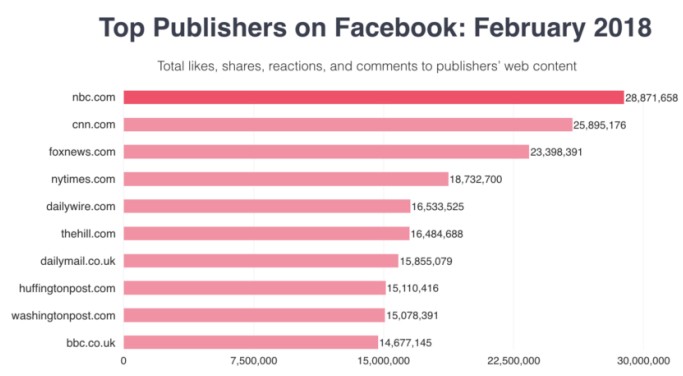Sign up for The Media Today, CJR’s daily newsletter.
Earlier this year, Facebook announced a change to its News Feed algorithm designed to reduce the visibility of news—apart from those outlets deemed to be high quality or trusted sources. Instead, as of January the social network said it would favor posts by people and pages, to encourage what it called “meaningful interaction.” What effect has this had on the flow of fake and/or real news? According to a newly released study from media-monitoring firm NewsWhip, real news is doing well since the change, but so are obvious misinformation and clickbait.
In the report, “Navigating the Facebook Algorithm Change,” the firm looks at the most widely shared articles since the algorithm change and finds that more than half of the top 100 were hard news stories or reporting on current events, such as the death of famed astrophysicist Stephen Hawking. But clearly false stories also show up fairly high in the rankings: Number 26 on the most-shared list is a report from a fake news site called Your Newswire that says the flu shot is causing a “disastrous flu outbreak.” That story got more than 850,000 engagements.

Although the algorithm change has resulted in a decline in traffic to some sites (including apparently conservative sites, which are complaining that they have been deliberately targeted), NewsWhip’s analysis shows that some news outlets have actually seen an increase in traffic since the change, including NBC and Fox News. January was the strongest month for Fox since October of 2017, the company says, and NBC took the top spot for the first time since January of last year. More niche sites have suffered:
Some Pages that our data showed a more serious decline in average engagements were UNILAD, Student Problems, 9Gag, Cosmopolitan, and Architecture & Design, though some of these are starting to show some recovery. For these publishers, it might be time to look at what role their content actually serves their followers — is it connecting them to one another, teaching them something new, making them pause… or is it just adding to a landscape of digital waste?
NewsWhip also finds that Facebook is true to its word, and has been favoring posts that get more engagement, including comments. Over the past couple years, the number of comments as a proportion of the overall engagement on the top 100 posts has averaged about 5 percent. Since the algorithm change, comments make up more than 11 percent of total engagement on the top 100 most-shared posts. Most of the ones that got a large number of comments were funny, clickbait-style videos.
Has America ever needed a media defender more than now? Help us by joining CJR today.


